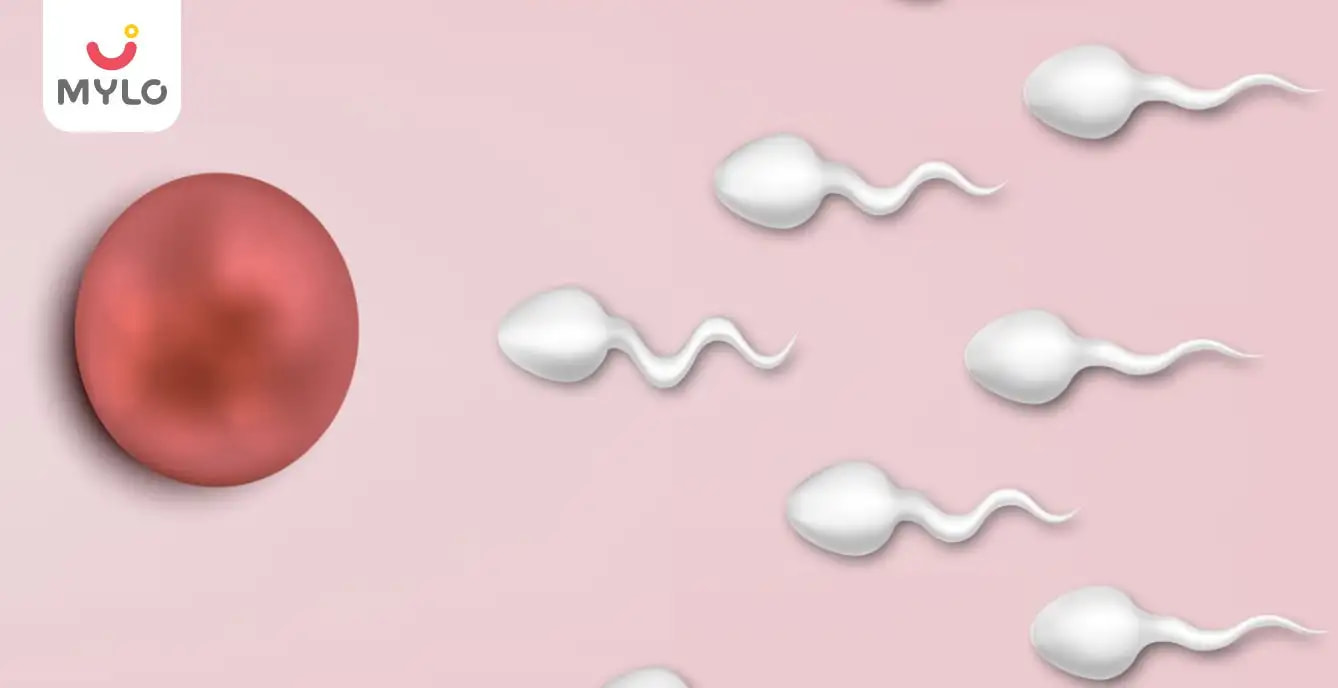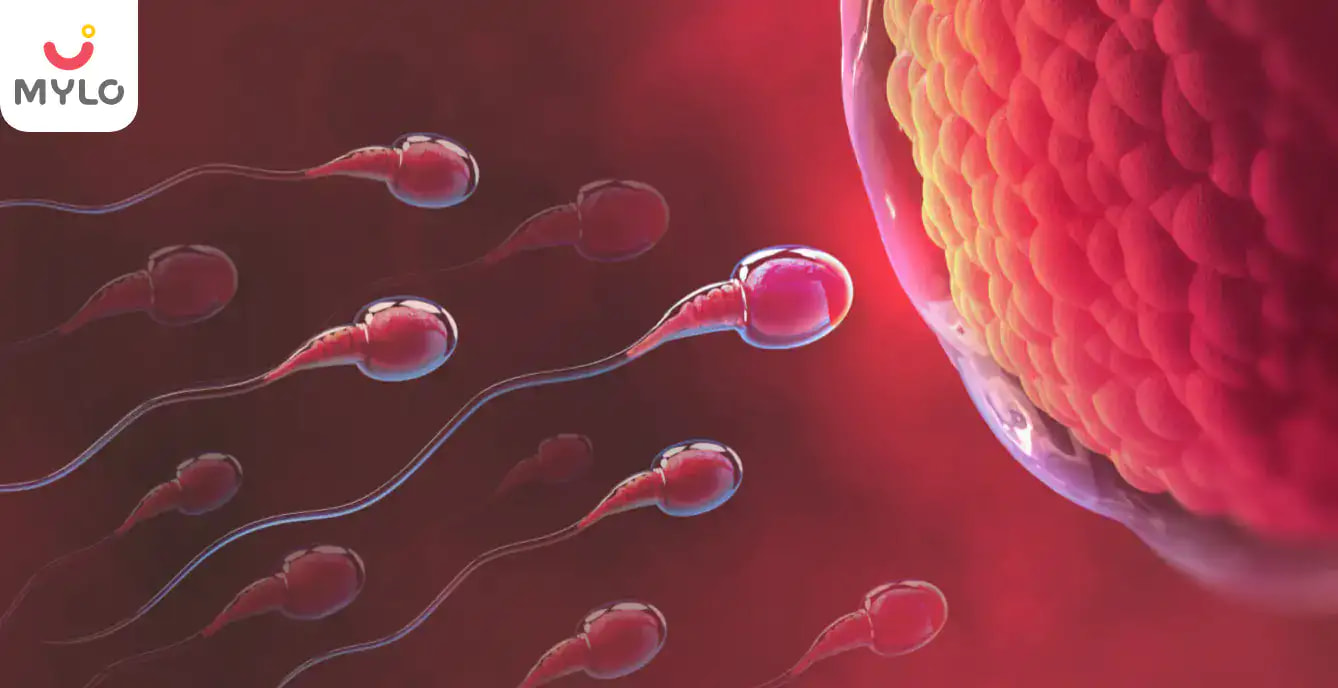Home

Conception

How Long Does Sperm Take to Reach the Egg?
In this Article

Conception
How Long Does Sperm Take to Reach the Egg?
Updated on 12 December 2023
We are aware that for pregnancy to occur, an egg must be fertilized by a sperm. While it may seem straightforward, there are intricacies involved that may surprise you. If you're actively trying to conceive and wish to gain a better understanding of the conception process, you might be curious about how long does sperm take to reach the egg.
In this article, we will talk about all things conception such as: how much time sperm take to reach egg, how many sperm are needed to fertilize an egg, what are the odds of sperm meeting the egg, is there any pain when egg meets sperm and more.
What are the chances of sperm meeting egg?
When it comes to the possibility of sperm meeting the egg, timing is everything. The female reproductive system is a complex and intricate network of organs that work together to facilitate conception. On average, the chances of sperm meeting the egg during each menstrual cycle are relatively low.
It is estimated that only about 25% of couples will conceive within the first month of trying, and the chances increase to about 85% within one year of trying. However, many factors can affect these statistics, such as age, overall health, and fertility issues.
You may also like: First-Time Sex & Pregnancy Chances: What You Need to Know
How does the sperm reach the egg?
In order to understand how much time sperm take to reach egg after intercourse, first we must understand how the sperm reaches the egg. When a woman ovulates, which usually occurs around the middle of her menstrual cycle, an egg is released from the ovary into the fallopian tube. The fallopian tube is where fertilization takes place.
If sperm are present in the fallopian tube at this time, they have the opportunity to meet and fertilize the egg. Sperm can reach the fallopian tube by swimming through the cervix and into the uterus. From there, they make their way up into the fallopian tube.
How long does sperm take to reach the egg?
Once sperm are inside the female reproductive system, they can survive for up to five days. However, the window of opportunity for fertilization is much smaller. The egg is only viable for about 12-24 hours after ovulation. Therefore, for conception to occur, sperm must meet the egg within this narrow timeframe.
In general, it takes sperm about 6-8 hours to travel from the cervix, through the uterus, and into the fallopian tube. Once in the fallopian tube, they have to navigate the complex structure and make their way to the egg. This process can take anywhere from a few minutes to several hours, depending on the individual sperm and the conditions within the reproductive system.
You may also like: After Sex How Many Days to Get Pregnant: Your Timeline to Conception
How many sperm are needed to fertilize an egg?
Contrary to popular belief, it only takes one sperm to fertilize an egg. When sperm reach the fallopian tube, they release enzymes that help them penetrate the outer layer of the egg. Once inside, the sperm and egg fuse together, combining their genetic material to create a unique individual.
However, the journey to fertilization is not an easy one for sperm. On average, only a small fraction of the millions of sperm released during ejaculation will make it to the fallopian tube. From there, only a few hundred will reach the vicinity of the egg. Out of those, only one lucky sperm will successfully penetrate the egg and fertilize it.
Do you feel any pain when egg meets sperm?
The process of fertilization itself does not typically cause any pain or discomfort. The egg and sperm are microscopic, and their meeting is not something that can be felt by the woman. However, some women may experience mild cramping or discomfort during ovulation, which is when the egg is released from the ovary. This is known as mittelschmerz, and it can occur on either side of the lower abdomen. It is believed to be caused by the stretching of the ovarian wall as the follicle containing the egg ruptures. This pain is usually short-lived and subsides on its own.
Are there any symptoms when sperm meets eggs?
Unlike the absence of any physical sensation when the egg meets sperm, there are no specific signs of sperm fertilizing egg. In fact, most women will not experience any noticeable symptoms until after they have missed their period, which is typically around two weeks after fertilization.
At this point, hormonal changes in the body may cause symptoms such as breast tenderness, fatigue, and increased urination. However, these symptoms can also be attributed to other factors, so it is important not to rely solely on them as an indication of pregnancy. The most accurate way to determine if fertilization has occurred is by taking a pregnancy test.
You may also like: Pregnancy Symptoms After Ovulation Day by Day: Exploring the Daily Progression
Final Thoughts
The journey of sperm to meet the egg is a remarkable feat of nature. From the moment of ejaculation to the fusion of genetic material, the process is filled with challenges and obstacles. Timing, health, and sheer luck all play a role in the chances of successful fertilization. Understanding how long does sperm take to reach the egg and other conception facts can help individuals and couples navigate their fertility journey with knowledge and confidence.
References
1. Settlage, D. S., et al. (1973). “Sperm Transport from the External Cervical Os to the Fallopian Tubes in Women: A Time and Quantitation Study.” Fertility and Sterility
2. Alberts, Bruce, et al. (2002). Fertilization. Garland Science
3. Carlson, Bruce M. (2019). “Chapter 14 - The Reproductive System.” The Human Body, edited by Bruce M. Carlson, Academic Press



Written by
Anupama Chadha
Anupama Chadha, born and raised in Delhi is a content writer who has written extensively for industries such as HR, Healthcare, Finance, Retail and Tech.
Read MoreGet baby's diet chart, and growth tips

Related Articles
Related Topics
RECENTLY PUBLISHED ARTICLES
our most recent articles

Ovulation
Pregnancy Symptoms After Ovulation Day by Day: Exploring the Daily Progression

Ovulation
Signs Ovulation is Over: Your Guide to Understanding the End of Ovulation

Stories
Top 15 Akbar and Birbal Stories for Young Kids

Abortion
How Soon After an Abortion Can You Get Pregnant?

PCOS & PCOD
PCOS and Sex: Exploring Impact on Health and Debunking Common Myths

PCOS & PCOD
Papaya for PCOS: Exploring the Link and How It Can Positively Impact Your Health
- How to Boost Fertility in Your 30s: The Ultimate Guide
- Anovulation Meaning Explained: What You Need to Know About Its Causes & Treatment
- Basal Body Temperature: How It Can Help You Track Ovulation?
- Ovulation Pain: Is It Normal or a Cause for Concern?
- Special Home Remedies For Gas During Pregnancy
- PCOD Problem After Marriage: Debunking Common Misconceptions and Finding Solutions
- White Discharge After Ovulation: A Normal Occurrence or Cause for Concern?
- Normal Ovary Size: How It Varies and What It Means for You
- 2024 Calendar with Holidays and Festivals of India
- After-Abortion Sex: A Guide to Physical and Emotional Wellness
- Cervical Cerclage: A Closer Look at the Procedure and Its Benefits
- The Ultimate Guide to Panchatantra Stories for Kids
- Which Is Better Normal Or Cesarean Delivery
- How to Get Baby in Right Position for Birth?


AWARDS AND RECOGNITION

Mylo wins Forbes D2C Disruptor award

Mylo wins The Economic Times Promising Brands 2022
AS SEEN IN
















- Mylo Care: Effective and science-backed personal care and wellness solutions for a joyful you.
- Mylo Baby: Science-backed, gentle and effective personal care & hygiene range for your little one.
- Mylo Community: Trusted and empathetic community of 10mn+ parents and experts.
Product Categories
baby carrier | baby soap | baby wipes | stretch marks cream | baby cream | baby shampoo | baby massage oil | baby hair oil | stretch marks oil | baby body wash | baby powder | baby lotion | diaper rash cream | newborn diapers | teether | baby kajal | baby diapers | cloth diapers |








